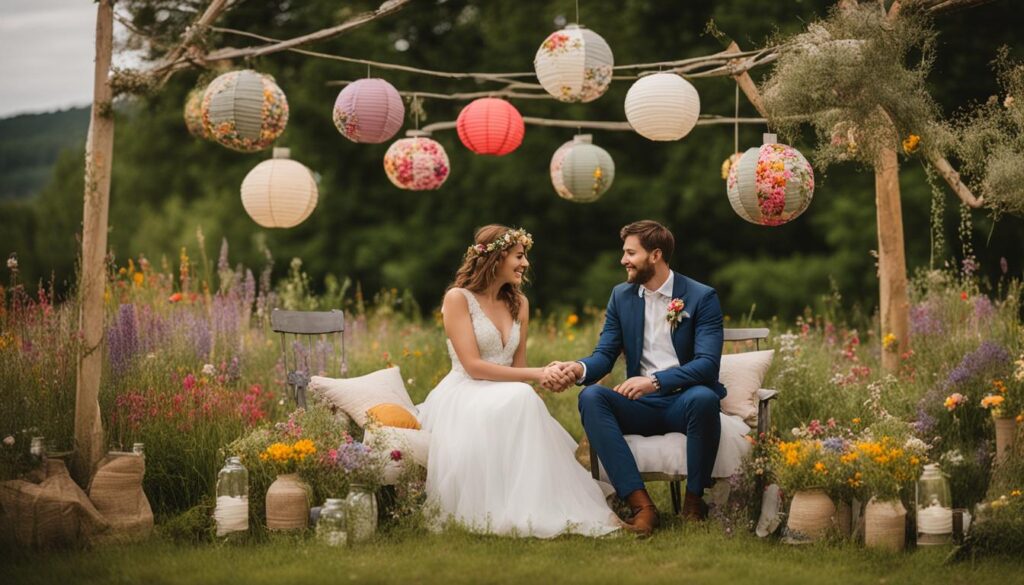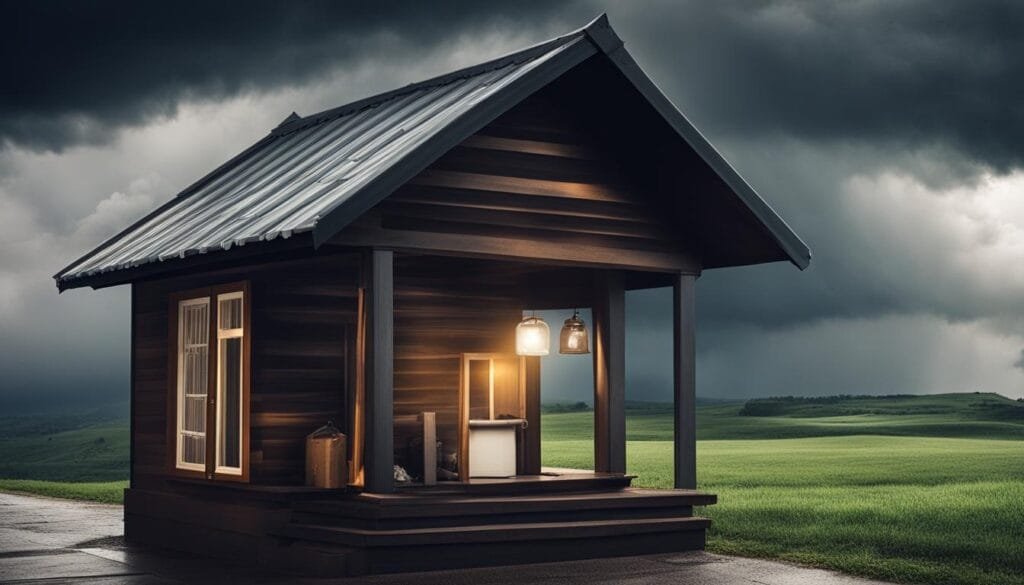Planning a memorable wedding can be a dream come true, but it’s no secret that weddings can come with a hefty price tag. However, with careful budgeting and smart spending, you can have the wedding of your dreams without draining your bank account. In this wedding budget guide, we’ll explore practical tips and tricks to help you navigate the world of wedding expenses and plan a wedding that fits your budget.
Key Takeaways:
- Budgeting for a wedding is essential to avoid financial strain.
- Prioritize essential elements of your wedding and allocate your budget accordingly.
- Consider DIY decorations and non-traditional venues to save costs.
- Getting married during off-peak seasons or on weekdays may lead to potential savings.
- Trimming the guest list and exploring alternative food options can help reduce expenses.
Setting a Realistic Wedding Budget
Before embarking on the exciting journey of planning your dream wedding, it’s crucial to set a realistic budget that aligns with your financial situation. A well-thought-out budget ensures that you can allocate funds appropriately and avoid any unnecessary financial strain. To help you stay organized and track your expenses, consider using The Knot’s wedding planning spreadsheet, a handy tool designed specifically for budget planning.
Discuss with your partner your financial goals and limitations, taking into account your savings, income, and any contributions from family members. It’s important to find a balance between your wedding aspirations and financial stability to ensure a stress-free planning process and a solid foundation for your future together.
Setting a Realistic Budget: Wedding Expenses Breakdown
Once you have an overall budget in mind, it’s time to break it down into specific categories and allocate funds accordingly. The table below provides a general breakdown of typical wedding expenses and the average percentage of the budget that should be allocated to each category. Keep in mind that these percentages can vary depending on your priorities and personal preferences.
| Expense Category | Percentage of Budget |
|---|---|
| Venue and Catering | 40% |
| Photography and Videography | 12% |
| Attire and Accessories | 10% |
| Flowers and Decorations | 10% |
| Entertainment | 8% |
| Stationery and Invitations | 4% |
| Transportation | 3% |
| Wedding Planner | 3% |
| Other Expenses | 10% |
While these figures serve as a general guide, it’s important to adjust the percentages based on your specific priorities. Allocate more to the elements that matter most to you, and consider cost-saving options for areas that are less essential. By setting a realistic budget and carefully managing your expenses, you’ll be able to have the wedding of your dreams without any financial stress.
Prioritizing Wedding Expenses
When planning your wedding on a budget, it’s important to prioritize your spending to make the most of your allocated funds. By identifying the important elements of your wedding and allocating your budget accordingly, you can still have a beautiful celebration without breaking the bank.
Start by determining two or three non-negotiable aspects of your wedding that hold the most significance to you. This could be the venue, the photographer, or any other element that you believe will make your day truly special. Allocate a larger portion of your budget to these key elements to ensure that they meet your expectations.
On the flip side, identify areas where you can save money by opting for more budget-friendly options. For example, you could cut costs on favors, elaborate decorations, or unnecessary extras that don’t hold as much value to you. By being selective with where you spend your money, you can create a balanced budget that allows you to focus on what truly matters.
To help you visualize your budget allocation, here’s a breakdown of how you might distribute your funds:
| Element | Budget Allocation |
|---|---|
| Venue | 30% |
| Photographer | 25% |
| Catering | 20% |
| Attire | 15% |
| Decorations | 10% |
Remember, this is just an example, and you can adjust the percentages based on your own priorities and budget constraints. The key is to be intentional and strategic with your spending, ensuring that your budget aligns with what truly matters to you on your special day.
Getting Creative with DIY Decorations
One of the best ways to save money on your wedding decorations is by getting creative with DIY projects. Not only will it help you stay within your budget, but it will also add a personal touch to your special day. DIY decorations can range from handmade centerpieces and floral arrangements to personalized wedding signs and photo booths. The possibilities are endless!
To get started, gather inspiration from websites like Pinterest, where you can find countless ideas and tutorials. Decide on a theme or color scheme that matches your wedding vision and start brainstorming DIY projects that align with it. Don’t be afraid to think outside the box and incorporate unique materials or repurpose items you already have.
Personalized Wedding Signs
One popular DIY decoration idea is creating personalized wedding signs. These signs can be used to guide guests, display seating arrangements, or simply add a charming touch to your venue. You can make them using chalkboards, wooden boards, or even repurposed window frames. Add your own artistic flair by using calligraphy or stencils to write out the messages.
Another idea is to incorporate your wedding hashtag into the signs, encouraging guests to share their photos on social media. This not only adds an interactive element to your wedding but also creates lasting memories captured by your guests.
| DIY Wedding Sign Ideas | Materials Needed |
|---|---|
| Welcome Sign | Wooden board, paint, stencils |
| Directional Signs | Arrow-shaped wooden boards, paint |
| Seating Chart | Chalkboard, chalk or chalk markers |
Remember, DIY decorations require time and effort, so make sure to plan ahead and allocate enough time for crafting and assembling. Enlist the help of friends and family to make the process more enjoyable. By getting creative with DIY decorations, you can transform your venue into a personalized and budget-friendly reflection of your love story.

Choosing an Affordable Time and Venue
When it comes to planning a wedding on a budget, choosing the right time and venue can make a significant difference. By considering off-peak wedding dates and non-traditional venues, you can save money without compromising on the overall experience. Let’s explore some strategies to help you make the most out of your wedding budget.
Off-Peak Wedding Dates
One of the key ways to save money on your wedding is by selecting an off-peak wedding date. The peak wedding season typically falls during spring and summer, where costs tend to be higher due to high demand. Consider getting married during the fall or winter months when the demand is lower, resulting in potential cost savings. Weekdays are also worth considering, as venues and vendors often offer discounted rates for events held during these less-popular days.
Non-Traditional Venues
Another effective strategy to reduce wedding costs is by opting for a non-traditional venue. Traditional wedding venues such as hotels or banquet halls can be expensive, whereas alternative options can offer a unique and budget-friendly experience. Parks, gardens, art galleries, or even a family member’s backyard can provide a charming setting for your special day. These non-traditional venues often come with lower rental fees, allowing you to allocate more budget to other essential aspects of your wedding.
By carefully choosing an affordable time and venue for your wedding, you can significantly reduce costs without compromising on the quality of the occasion. Remember, it’s all about thinking creatively and finding unique alternatives that align with your vision and budget.
Trimming the Guest List
Keeping your guest list under control is essential for a budget-friendly wedding. By trimming the guest list, you not only save on catering costs but also create a more intimate and meaningful experience. Instead of inviting distant relatives or acquaintances, focus on inviting close family members and friends who truly matter to you.
Having a small ceremony with a limited number of guests allows you to allocate your budget towards other aspects of your wedding that are important to you. Whether it’s investing in a stunning venue, a talented photographer, or personalized details, a smaller guest list gives you the opportunity to prioritize and make your wedding truly special.
Remember, a smaller guest list does not mean your wedding will be any less memorable or enjoyable. In fact, it can create a more intimate atmosphere where you can truly connect and celebrate with your loved ones. Your wedding day is about sharing your special moment with those who mean the most to you, and a smaller guest list ensures that the focus remains on the love and joy you share as a couple.

Table: Advantages of Trimming the Guest List
| Advantages | Description |
|---|---|
| Saves on catering costs | By reducing the number of guests, you can save significantly on catering expenses, allowing you to allocate more funds towards other wedding priorities. |
| Creates an intimate atmosphere | A smaller guest list creates a more intimate and meaningful experience, allowing you to connect more deeply with each guest and create lasting memories. |
| Allows for prioritization | With a limited number of guests, you can prioritize other important aspects of your wedding, such as the venue, photographer, or personalized details, making your day truly special. |
| Enhances the focus on love and joy | A smaller guest list ensures that the focus remains on the love and joy you share as a couple, allowing for a more meaningful and celebratory experience. |
Exploring Affordable Food Options
When it comes to planning a budget-friendly wedding, finding affordable food options can significantly reduce your overall expenses. Gone are the days of traditional multi-course meals that break the bank. Instead, consider alternative food choices that not only save money but also add a unique touch to your special day.
One popular option is a buffet reception, where guests can enjoy a wide variety of dishes at their leisure. Buffets are not only cost-effective but also allow guests to customize their meals according to their preferences. It’s a great way to accommodate different dietary restrictions and preferences without the need for multiple menu options.
If you want to take it a step further, food stations can provide a more interactive experience for your guests. Set up stations with different cuisines or food themes, such as a taco bar or a build-your-own pasta station. This not only adds excitement but also encourages guests to mingle and try different flavors.
Thinking outside the box can also lead to creative food choices that are both budget-friendly and memorable. Consider alternatives to traditional catering, such as food trucks or even a potluck-style reception. Food trucks are a fun and trendy option that can provide a unique dining experience for your guests. On the other hand, a potluck-style reception allows your loved ones to contribute their favorite dishes, creating a sense of community and shared celebration.
Table: Comparison of Food Options
| Food Option | Advantages | Considerations |
|---|---|---|
| Buffet Reception | Cost-effective, customizable meals, accommodates dietary restrictions | May require additional servers and space |
| Food Stations | Interactive experience, encourages mingling, variety of flavors | Requires careful planning for flow and space |
| Food Trucks | Unique dining experience, trendy, adds excitement | Requires coordination and permits depending on venue |
| Potluck-Style Reception | Community and shared celebration, cost-effective | Requires coordination and communication with guests |
Remember, your wedding is a reflection of you as a couple. By exploring affordable food options, you can create a unique and memorable dining experience without stretching your budget. Whether it’s a buffet reception, food stations, or alternative catering choices, your guests will appreciate the thought and creativity put into your menu selection.
Conclusion
Planning a wedding on a budget doesn’t mean compromising on your dreams. With savvy wedding planning and resourcefulness, you can have a beautiful and memorable celebration without breaking the bank.
Start by setting a realistic wedding budget that aligns with your financial stability. Use tools like The Knot’s wedding planning spreadsheet to keep track of expenses and ensure you stay within your limits.
Next, prioritize your spending by identifying the important elements of your wedding. Allocate your budget to the non-negotiable aspects, such as the venue or photographer, and save on less crucial items like favors or elaborate decorations. This way, you can make the most of your budget and still have the wedding you’ve always envisioned.
Get creative with DIY decorations to add a personal touch to your wedding. Pinterest is a great resource for finding inspiration. Involve friends and family in a crafty day of creating wedding decor, saving money while making your celebration feel extra special.
Consider getting married during off-peak seasons or on weekdays to secure your dream venue at a lower cost. Non-traditional venues like parks or a backyard can also add a unique charm to your day while being more budget-friendly.
Trimming the guest list to close family and friends or having a small, intimate ceremony can help control costs and create a more intimate atmosphere.
Opt for affordable food options like buffet receptions or food stations instead of pricey multi-course meals. This not only saves money but also adds a more interactive and enjoyable experience for your guests.
Remember, planning a wedding on a budget requires careful consideration and organization. By following this wedding budget guide, you can have a memorable celebration while staying within your financial means. Happy planning!
FAQ
How do I set a realistic wedding budget?
It’s important to determine a budget that you can afford. Discuss with your partner and use tools like The Knot’s wedding planning spreadsheet to keep track of expenses. By having open conversations about your financial goals and priorities, you can avoid potential conflicts later on. Additionally, consider researching couples budgeting strategies that have worked for others, as they can provide valuable insights and help you stay on track. Remember, creating a realistic budget not only alleviates stress but also allows you to focus on enjoying the planning process together.
How can I prioritize wedding expenses?
Figure out what is most important to you and allocate your budget accordingly. Choose two or three non-negotiable aspects, like the venue or photographer, and save money on less crucial items.
Any tips for DIY decorations?
Get creative and use DIY decorations to add charm to your wedding without overspending. Pinterest is a great resource for ideas. Gather friends and family to help you create personalized decor.
Are there affordable time and venue options?
Consider getting married during off-peak seasons or on weekdays. Non-traditional venues like parks or a backyard can also add a special touch and help you save money.
How do I trim the guest list?
Keep your guest list intimate by inviting close family and friends. Consider having a small, intimate ceremony. Remember, the quality of the company matters more than the quantity.
What are some affordable food options?
Instead of pricey multi-course meals, opt for budget-friendly options like buffets or food stations. You can also consider alternatives to traditional catering, such as food trucks or potluck-style receptions.
How do I plan a wedding on a budget?
Careful consideration, prioritization, and resourcefulness are key. Set a realistic budget, allocate funds to important elements, and get creative with DIY decorations and alternative venues. Stay organized and plan ahead for a stress-free experience.
How Can Zero-Based Budgeting Help Me Save Money on My Wedding?
Planning a wedding can be a daunting task both emotionally and financially. However, by embracing zero-based budgeting secrets for maximizing dollars, you can effectively save money on your big day. This approach involves thoroughly assessing your expenses and allocating funds accordingly, helping you prioritize the aspects that truly matter while eliminating unnecessary expenditures. With zero-based budgeting, you can create a memorable wedding without breaking the bank.
Source Links
- https://www.centralbank.net/learning-center/tie-the-knot-without-breaking-the-bank-infographic/
- https://theaudioguestbook.co/tie-the-knot-without-breaking-the-bank-a-budget-friendly-guide-to-planning-your-dream-wedding/
- https://goweddingsza.co.za/2023/04/16/ultimate-guide-to-planning-a-perfect-wedding-2/

